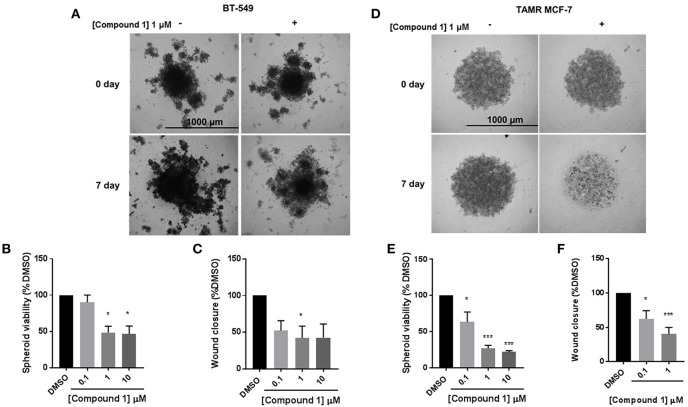Figure 5.
Compound 1 inhibits spheroid viability and cell migration in BT-549 and TAMR MCF-7 cells. (A) Spheroid formation in BT-549 cells after treatment with DMSO or compound 1 at 1 μM concentration for 7 days, scale bar 1,000 μm. (B) Quantification of the spheroid viability in BT-549 cells after treatment with compound 1 at increasing concentrations (0.1, 1, 10 μM) after 7 days of treatment, data represents ± SEM *p < 0.05; ***p < 0.001 vs. control group determined by one-way ANOVA with the Bonferroni post hoc test in BT-549 cells. (C) Wound closure was measured after treatment with increasing concentrations (0.1, 1, 10 μM) of compound 1. The data is presented as a percentage of untreated DMSO control group. *p < 0.05 vs. control group determined by one-way ANOVA with the Bonferroni post hoc test (BT-549 cells). (D) Spheroid formation in TAMR MCF-7 after treatment with DMSO or compound 1 at 1 μM concentration for 7 days, cells scale bar 1,000 μm. (E) Quantification of the spheroid viability after treatment with compound 1 at increasing concentrations (0.1, 1, 10 μM) after 7 days of treatment in TAMR MCF-7 cells, values indicate ± SEM of three experiments run in triplicate. *p < 0.05 vs. control group determined by one-way ANOVA with the Bonferroni post hoc test in TAMR MCF-7 cells. (F) Wound closure was measured after treatment with increasing concentrations (0.1, 1, 10 μM) of compound 1. The data is presented as a percentage of untreated DMSO control group. *p < 0.05; ***p < 0.001 vs. control group determined by one-way ANOVA with the Bonferroni post hoc test (TAMR MCF-7 cells).

